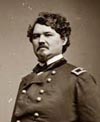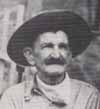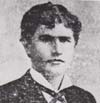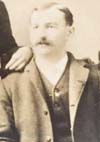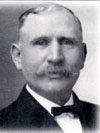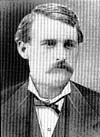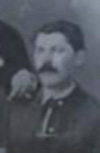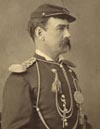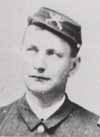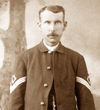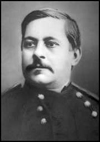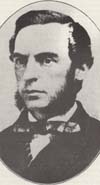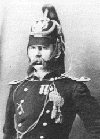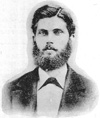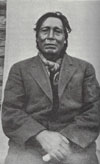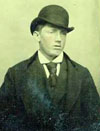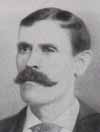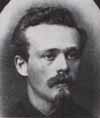Samuel Davis Sturgis (left) was born in Shippensburg, Pennsylvania, on June 11, 1822. Colonel Sturgis was an 1846 graduate of the United States Military Academy at West Point who was Commanding the 7th Regiment of Cavalry at the time of the battle but was on detached service in St. Louis, Missouri. Unfortunately, his son, Second Lieutenant James Garland Sturgis, was with Company E during the battle and was killed.
Edward D. Pigford (left) was born on June 11, 1856, in West Elizabeth, Pennsylvania. He was a Private in Company M who was wounded during the valley and hilltop fights.
William Heyn (right) died in Washington, D.C., on June 11, 1910, and was buried in the Soldiers’ Home National Cemetery there. According to the April 1910 federal census, he was working as an office clerk, and he and his wife Sarah had been married for just one year. He was a First Sergeant in Company A who was wounded in his left knee during the valley and hilltop fights.
Peter Eixenberger (left) was born on June 12, 1860, in Munich, Germany. He was a Private with the Band, so he was at Powder River, Montana, during the battle. See also 7th Cavalry Troopers in South Dakota.
Peter Gannon died at Fort Assinniboine, Montana Territory, on June 12, 1886. He was first buried in a cemetery there and later reinterred in the Custer National Cemetery on the Crow Agency, Montana. He was a Sergeant in Company B who was not present at the battle due to detached service at the Powder River camp.
Michael Murphy died on June 12, 1904, at the Soldiers’ Home in Washington, D.C., and was buried in the National Cemetery there. He was a Private in Company K who participated in the hilltop fight.
John H. Day was lynched for arson in Monroe, Ouachita Parish, Louisiana, on June 13, 1894, and was buried in the Old City Cemetery there. He was a Private in Company H who was with the pack train and participated in the hilltop fight during the battle.
George Anderson was born on June 14, 1841, in St. Catherines, Canada. He was a Private in Company K who was not present at the battle because he was a laborer for the quartermaster department at Fort Abraham Lincoln.
Alexander Downing (left) married Ida Martha Conway in Miami County, Ohio, on June 14, 1882. He was a Private in Company F who was not present at the battle due to detached service at Fort Abraham Lincoln, Dakota Territory.
John Samuel Ragsdale married Vena Bells Owens on June 14, 1926, in Richmond, Indiana, but they divorced after 1940. He was a Private in Company A who was not present at the battle due to detached service at Powder River, Montana.
Christopher Pendle (left) was born on June 15, 1849, in Bavaria, Germany. He was a Private in Company E who was not present at the battle due to serving as a hospital nurse on the Far West.
James O’Neill was born in Liverpool, England, on June 15, 1851. He was a Private in Company B who was not present at the battle due to illness.
Charles Windolph (right), who was also known as Charles Wrangel, married his first wife, Mary Jones, on June 15, 1882. He was a Private in Company H who was wounded in the hilltop fight. He was awarded both the Medal of Honor and the Purple Heart for his service during the battle.
George B. Herendeen (left) died on June 17, 1919, in Havre, Montana, and was buried in Harlem Cemetery in Harlem, Montana. He was a Scout who participated in the valley and hilltop fights during the battle.
